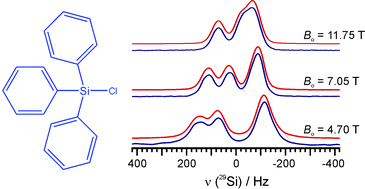A solid-state nuclear magnetic resonance and zeroth-order regular approximation density functional theory, ZORA-DFT, study of one-bond nuclear spin–spin coupling between group-14 nuclei and quadrupolar 35/37Cl nuclei in triphenyl group-14 chlorides, Ph3XCl (X = C, Si, Ge, Sn and Pb), is presented. This represents the first combined experimental and theoretical systematic study of spin–spin coupling involving spin-pairs containing quadrupolar nuclei. Solid-state NMR spectra have been acquired for all compounds in which X has a spin-1/2 isotope—13C, 29Si, [117/119]Sn and 207Pb—at applied magnetic fields of 4.70, 7.05 and 11.75 T. From simulations of these spectra, values describing the indirect spin–spin coupling tensor—the isotropic indirect spin–spin coupling constant, 1J(X,35/37Cl)iso and the anisotropy of the J tensor, Δ1J(X,35/37Cl)—have been determined for all but the lead–chlorine spin-pair. To better compare the indirect spin–spin coupling parameters between spin-pairs, 1Jiso and Δ1J values were converted to their reduced coupling constants, 1Kiso and Δ1K. From experiment, the sign of 1Kiso was found to be negative while the sign of Δ1K is positive for all spin-pairs investigated. The magnitude of both 1Kiso and Δ1K was found to increase as one moves down group-14. Theoretical values of the magnitude and sign of 1Kiso and Δ1K were obtained from ZORA-DFT calculations and are in agreement with the available experimental data. From the calculations, the Fermi-contact mechanism was determined to provide the largest contribution to 1Kiso for all spin-pairs while spin-dipolar and paramagnetic spin–orbit mechanisms make significant contributions to the anisotropy of K. The inclusion of relativistic effects was found to influence K(Sn,Cl) and K(Pb,Cl).


 Please wait while we load your content...
Please wait while we load your content...